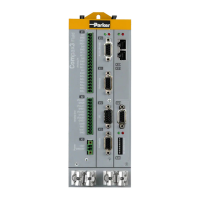Parker Hannifin
Programming Basics
The following section explains some fundamental concepts of the
AcroBASIC programming language.
Aliases
Alternative names, called aliases, can be assigned to parameters,
bits, constants, and variables to make program code more
readable. Aliases are recognized globally (across user programs).
NOTE: Do not confuse aliases with axis names. You can assign an
axis name to an axis through the ATTACH SLAVE command.
Observe the following rules when creating and using aliases:
• Use a maximum of 24 letters.
• Aliases are case sensitive.
• Do not use numbers, spaces, or special characters (such as _
and @).
• Use caution when using aliases with local variables.
An alias is recognized across programs, while local variables
are limited to the program in which they are created. This can
cause problems if you have created similar local variables in
different programs. For example, if long variables are
dimensioned in three programs, then the alias “counter” is
assigned to LV1 (long variable 1), the controller recognizes
“counter” as an alias in all three programs, though it represents
a counter in only one program.
For more information, see the #DEFINE command in the ACR
Command Language Reference.
► To assign aliases, use the #DEFINE command.
Program Labels
Labels are program pointers which provide a method of branching
to specific locations, including subroutines, within the same
program. Labels can only be defined within a program and
executed with a GOTO or GOSUB from within the same program.
Observe the following rules when creating and using labels:
• Precede the label with an underscore ( _ ) character.
• Use letters (case-sensitive) and numbers, but not spaces or
symbols.
Programming Basics 7

